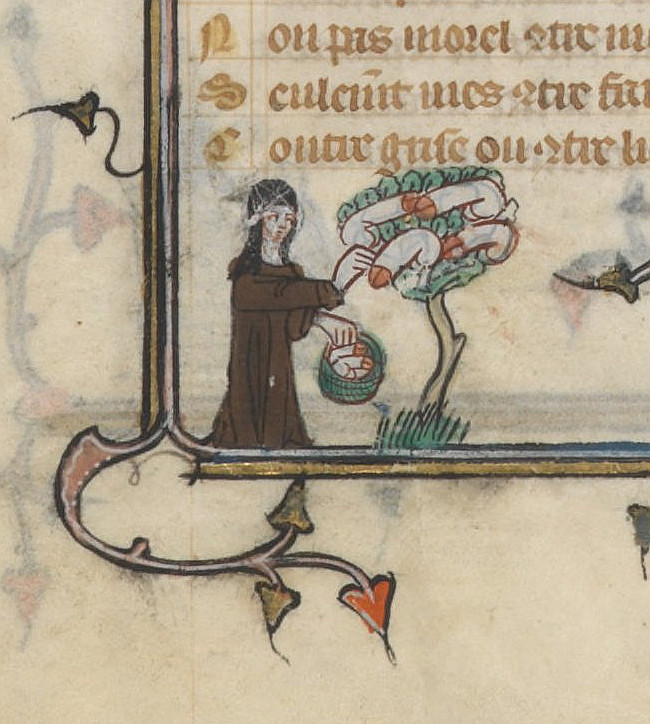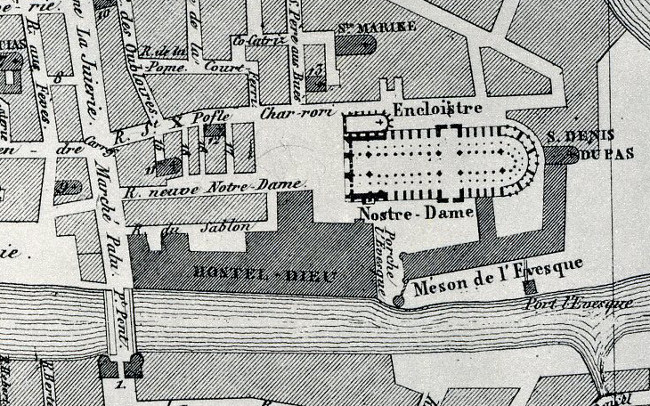The Phallus Tree of fr. 25526
The Bibliothèque nationale de France houses a particularly strange manuscript of Guillaume de Lorris’ and Juen de Meun’s Roman de la Rose: BNF fr. 25526. It is famous for its extensive bas-de-page images, several of which are of an explicitly erotic nature. One image in particular often serves as an exemplar of strange medieval marginalia - that found on page 106v, of a nun gathering the fruit of a phallus tree:

Nun at Phallus Tree. BNF fr. 25526, 106r
This single image is part of a series on pages 106r and 106v showing a nun and a friar engaged in erotic play. These same figures appear again on pages 111r and 111v.
Interestingly in her book, “Roman de la Rose and its Medieval Readers”, Dr. Sylvia Huot of Pembroke College, Cambridge points out that all of these images are part of a single bifolium; that is, a single double page that is folded in half and sewn into a quire. From the perspective of the illustrator working on the bifolium, all eight individual images form one extended series:
Because the bifolium if folded in half, the images on the top right (i.e., 111v, Copulation; Mule with phalluses) becomes the final scene in the series:
- 106r: Nun leads monk, Monk scales tower
- 106v: Nun at phallus tree; Nun and monk embrace
- 111r: Monk kneels; Couple undresses
- 111v: Copulation; Mule with phalluses
This manuscript was produced by the professional husband and wife team of Richard and Jean de Montbaston working out of their shop on the Rue Neuve Notre Dame in Paris.
In their book, “Manuscripts and their makers: commercial book producers in medieval Paris, 1200-1500”, Richard and Mary Rouse, show that the wife, Jean de Montbaston, was responsible for virtually all the illustrations in fr. 25526 and that interestingly, she was most likely illiterate(!). Book makers such as the Montbastons worked as speedily as possible and devoted little if any time for literary interpretations. Often in fact, their cursory view could result in illustrations that completely misrepresent the text.

Advertisement for Richard de Montbaston. BNF fr. 241
As specific and unambiguous as the tale appears to be, unfortunately, there is no known story which explicitly describes a friar and a nun as depicted in the bas-de-page images. The Rouse’s remark that the best that could be said is that they reflect some “bawdy tale” that Jean had perhaps heard during the course of her work.
That actual layout of the story is even in question. Many of the illustrations in the book are temporally out of order. For example, in the interleaving stories of the Passions of Christ and St. Margaret, Montbaston seems to be aware that the left side of the bifolium will come after the right side when folded and so puts the left side image:
- Descent from the Cross : Crucifixion
- Burial : Resurrection
Here the illustrator understands that the Descent from the Cross occurs after the Crucifixion, and so puts that image to the right, thus when folded, Descent (53v) comes after Crucifixion (52r) . But then, oddly, she puts the Burial and Resurrection on the other side of that bifolium. This results in a confusing series of illustrations:

Passion of Christ bas-de-page images from 52r, 52v, 53r and 53v
All of the aspects of the Passion stories follow this same disjointed pattern.
Does the erotic nun and friar tale follow this same pattern? If so, the story would flow in a way that makes even less sense:
- 106r: Nun leads monk, Monk scales tower
- 111v: Copulation; Mule with phalluses
- 106v: Nun at phallus tree; Nun and monk embrace
- 111r: Monk kneels; Couple undresses
Given what is known about Jean de Montbaston’s literacy and the speed with which she worked, the best I think can be said is that she managed to get the ordering “correct” this time. Still, what ultimately is the source of these strange images? Unfortunately, the answer is probably unknowable.
Images have phallus trees have appeared in other contexts, e.g., The Massa Marittima Mural, but any attempt to find meaning of them seems to result in series of circular references to the few examples that are known.






You do not know?
» Posted by Architect Marwan Yafi on May 13, 2013 06:59 PMThe Massa Marittima Mural?
Tree of abundance water?
Christianity is a Phallic religion!!!!!!!!!The Dove? Jews made it so, Saul-Paul’s Jewish group of Antioch.
John 4:14
King James Version (KJV)
14 But whosoever drinketh of the water that I shall give him shall never thirst; but the water that I shall give him shall be in him a well of water springing up into everlasting life.
Muslim